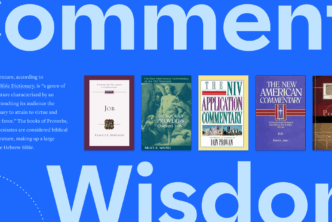My wife and I are missionaries in Cambodia, where I work as a Bible translation advisor for a local language, Jarai, and we both teach the Bible in various contexts. The Bible is important to us: not only how it is translated, but how it is used and understood.
A verse that we like to use in evangelistic teaching and discipleship is John 14:6. You can probably quote the verse. Go ahead and finish it: “I am the way [fill in the blank].”
How did you finish the first sentence? Did you say, “I am the way, the truth, and the life,” or did you say, “I am the way, AND the truth, and the life”? Chances are good that you left out the first “and.” If so, you’re in good company (if you consider me and the King James Version good company, that is).
Chances are also good that you recited the verse with a particular pattern of stress or emphasis, represented by the following italics: “I am the way, the truth, and the life.”
Both of these things—the single “and,” as well as the pattern of stress—can easily slip past our notice. But they reveal the ways the context of a verse shapes how we say it and how we understand it.
In what follows, I aim to re-situate John 14:6 in its original context and to explore what its place in that context means for the way we ought to read and think about this famous verse. At the end of this article, I return to the question of other contexts that the verse regularly finds itself in, especially as a stand-alone verse used for recitation and teaching.
Intonation and what’s “at issue”
I’ll start with the second issue I identified in our recitation of the verse; namely, the intonation. You probably said, “I am the way, the truth, and the life.” This is, in fact, how any native English speaker would inflect the sentence if he read it out of the blue. The italics simply represent the ordinary stress we put on the most important words—the nouns (way, truth, life)—in a parallel construction like this.
But this statement is part of a conversation. A little before this verse, in 14:2, Jesus said to his disciples, “I go to prepare a place for you”; then in 14:4 Jesus continues the thought, saying, “And you know the way to where I am going.” Thomas, confused, said, “Lord, we do not know where you are going. How can we know the way?” [κύριε, οὐκ οἴδαμεν ποῦ ὑπάγεις· πῶς δυνάμεθα τὴν ὁδὸν εἰδέναι;] (14:5).
Now read verse 6 again in that context. Thomas says, “How can we know the way?” And Jesus replies, not “I am the way,” but “I am the way”: the first-person pronoun, “I,” gets the vocal stress if you are following the context. (We don’t know enough about intonation in koine Greek to know just how ἐγώ εἰμι ἡ ὁδὸς would sound. But the issue here is the structure of the conversation and how it would sound in English.)
The question under discussion is not, “Who are you, Jesus?” but rather, “Where are you going, and what’s the way there?” The way we normally quote the verse provides an answer to the who question: “Do you want to know about Jesus? He said, ‘I am the way, the truth, and the life.’”
But the question in the text is, “How can we get to where Jesus is going? How do we get to the Father?” Jesus is the way to the Father.
And not just that
As far as Thomas is concerned, his question has been answered after the first four words of Jesus’s response. “You don’t know the way to the Father? Well, I am the way.” But then Jesus adds some additional information that Thomas didn’t ask about. He says that he’s also the truth and the life.
How do you inflect a sentence when you’re telling someone more than they’ve asked? Normally, in English at least, you put strong stress on the and that precedes the added information in order to clarify that now you’re going beyond a simple answer to their question. The best way to read Jesus’s response to Thomas (in English), then, is something like this:
Thomas: We don’t know the way.
Jesus: I am the way—and the truth, and the life.
If we understand the context—what linguists call “the question under discussion” or “what’s at issue”—there is really no other stress pattern that works. And reading it this way highlights the fact that Jesus has not only addressed Thomas’s concern (by saying he himself is the way), but has gone beyond that immediate concern to tell Thomas things that he hasn’t even asked about.
Thus the context absolutely requires the first and in English translation. If you leave it out, the way we usually do when we recite the verse, then Jesus’s response makes a somewhat incoherent contribution to the conversation, as though Thomas has asked Jesus to tell him a few things about himself, and Jesus responds with a list.
An example from ordinary life
In my work as a Bible translator for the Jarai language in northeast Cambodia, I find that our team of national translators sometimes gets stuck in unnatural “Bible” Jarai. One of the best solutions is to think through a situation from ordinary life that mirrors the biblical context but without the baggage of needing to sound, well, like the Bible. If you’re skeptical about my claims about intonation and ands, consider this mini conversation from English.
Mother: Who won the 100 meter?
Child: I won the 100 meter—and the 200 meter, and the pole vault.
Note that what’s “at issue” is the identity of the winner of the 100-meter race. The identity of that person, in this case the child (I), gets the stress. Note as well that the other events are add-ons; Mom didn’t ask about those. So the answer needs two ands, and they both get some stress.
Now, if the question were different, the intonation of the response would be different. Imagine this exchange:
Mother: What did you win today?
Child: I won the 100 meter, the 200 meter, and the pole vault.1
In this second conversation, the question is different, so the form of the response is different. Only one and is needed (though a second would be acceptable), and there’s no stress on either I or and.
I leave it to the reader to figure out which of these imaginary conversations is more like the context in John 14.
Formal or functional translation?
You may think that I’m making an argument for literal translation here: if Greek says και, English should say and. Is that what I’m saying? No.
Although most functional (dynamic) translations have only one and in John 14:6, and most formal (literal) translations have two ands, the NIV—a moderately functional translation—also translates John 14:6a with two ands. (David Suchet gets the intonation exactly right in his reading of the NIV’s John 14:6, as you’d expect.) The NABRE, which is a more thoroughgoing functional translation, also has two and‘s. On the other hand, the KJV and NKJV—both of which are quite formal translations—have only one and.
So what about the Greek? The Greek of John 14:6 has two instances of και: one before “the truth” (ἡ ἀλήθεια, the second item in the list) and another before “the life” (ἡ ζωή, the third item). But in fact, in the Greek of John’s Gospel, nearly all lists of three or more items have και before each item (besides the first item, of course). For example, in John 2:14, Jesus “found in the temple those that sold oxen and [και] sheep and [και] doves” (KJV). The NIV, which uses two ands in John 14:6, has only one and here in 2:14 (“people selling cattle, sheep and doves”), which is good, natural English in this context.
In other words, the Greek alone doesn’t tell us how many ands are needed in a list when that list is translated into English. Sometimes, as in John 14:6, there are contextual factors favoring a direct translation of all instances of και. Sometimes it’s best to have only one and, as in John 2:14.
Translators must pay attention to the form of the original, while also staying alert to the flow of information in the immediate context. A good translation will represent the original using English forms that capture both the meaning and the information structure of the original.2 In this case, the NIV has gotten it just right.
But so what?
So the KJV (along with a number of modern translations like the GNB, the NLT, and the CSB) left out an and. Is it really such a big deal?
It’s certainly not a matter of missing the truth about Jesus. But because biblical truth often comes packaged in stories and conversations, the packaging matters. In other words, translators ought to get the dynamics of the story or conversation correct.
And readers—the rest of us—ought to pay close attention when we read the stories and conversations, too. What should we pay attention to? We should notice what the conversation is about. We should notice who asks what, and what the answer is. We should think about what people know at various points in the conversation and how each “turn” in the conversation would have been heard by the original participants based on what they know—and what they want to know—at that point in the dialog.
Memorizing isolated Bible verses sometimes makes this practice difficult. When we get to a familiar verse like John 14:6, we think we already know it, and we may fail to consider how it must have sounded to Thomas when Jesus first said it.
All of this is another way of saying that we should read verses in context: not just historical or canonical or grammatical context, but we should read Bible sentences as though they had a real-life context—since they did. They were part of real conversations, real events, real letters to real churches.
What about memorizing and teaching verses?
At this point, you may think I’m against memorizing verses “out of context.” In fact, I’m not. My kids memorize proof texts to the catechism. My wife writes tunes to help our neighbors and local church kids memorize (de-contextualized!) verses in Khmer and Jarai. A verse out of context is still a repository of truth, often stated with pith. John 14:6 is a premium example.
But we have to recognize that reciting a Bible verse puts it in a new context, one that is different from the original context. Naturally in that new context, our recitation will not exactly match the wording and intonation of the verse in its original context. (In some contexts—say, a Bible verse song—it may even be useful to substitute the name Jesus for the pronoun I.) With this recognition, then, comes an obligation to supply some of the original context through teaching or storytelling, lest we begin to think of the verse as though it came to us scrawled all by itself on a scrap of papyrus. (No, P52 doesn’t include John 14:6!)
At their best, memorized verses function like signposts reminding us of essential truths, while also leading us back to larger contexts. To know that Jesus is the way, and the truth, and the life is a starting point. But if we want to know the way where, or the truth about what, or what kind of life, then we have to go back and read, and think, and perhaps even imagine ourselves as part of a conversation that took place two thousand years ago, a conversation that still has reverberations into the present and hopefully into our own lives.
Related articles
- 7 Things about the Bible I Wish All Christians Knew
- 29 Bible Study Tools for Reading the Bible More Effectively
- How to Use Linguistics to Understand the Bible
- Both examples from “ordinary life” given above are based on similar examples in Line Mikkelsen, Copular Clauses: Specification, Predication and Equation (Amsterdam: John Benjamins, 2005).
- More than anyone else, Paul Kroeger has taught me the importance of paying attention to information structure in translation. Anyone wanting to understand more about information structure should start with his work.






